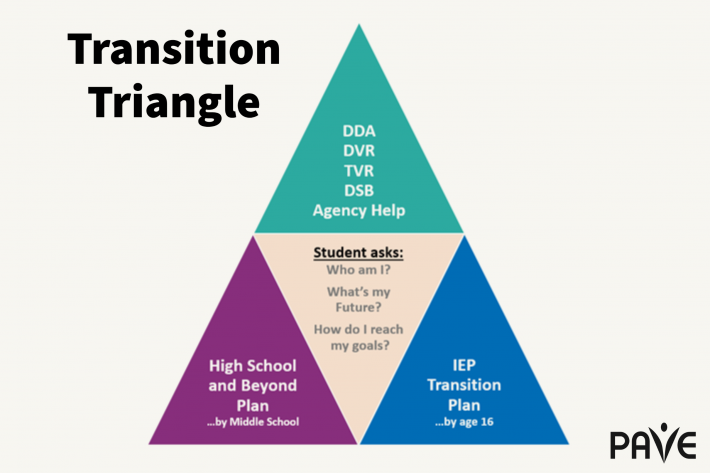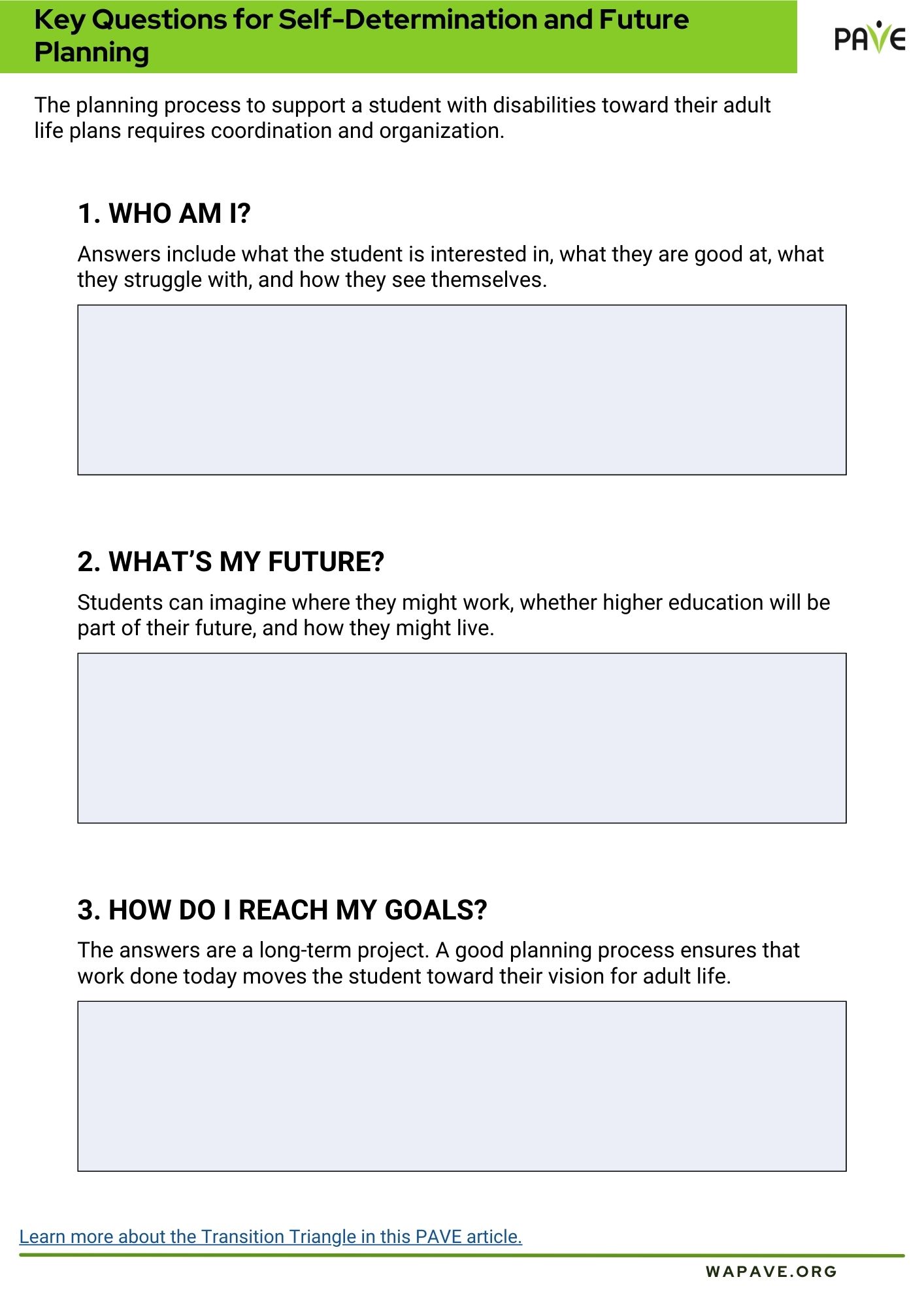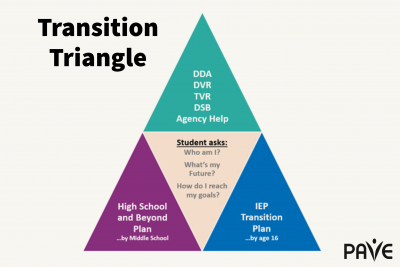A Brief Overview
- Vocational rehabilitation (VR) is a federal right. Pre-Employment Transition Services (Pre-ETS) are one way to get support. Another is through 1:1 counseling and an Individualized Plan for Employment (IPE).
- In Washington State, the Division of Vocational Rehabilitation (DVR) provides Pre-ETS and VR services. To seek support for a student still working toward a diploma, contact the DVR counselor assigned to the student’s school. DSHS maintains an interactive map: Find a School Transition Counselor.
- Individuals with vision impairment and blindness are served through a separate vocational rehabilitation agency in Washington State, the Department of Services for the Blind (DSB).
- After graduation, a student with a tribal affiliation may be eligible for support from Tribal Vocational Rehabilitation (TVR). Each TVR agency operates independently. Contact information is listed on a TVR website page, within DVR’s website.
- Graduating seniors can seek DVR, TVR, or DSB services now!
Full Article
Teenagers and young adults with disabilities have additional considerations when deciding what life looks like after high school. The transition planning process begins in middle school, when all Washington State students work with counseling staff to begin their High School and Beyond Plan.
For students with disabilities, that lengthy planning process is enhanced when the Individualized Education Program (IEP) adds a Transition Plan, required by the school year when a student turns 16.
Vocational rehabilitation agencies can be part of that process and support a warm hand-off into the world of work. PAVE provides an infographic Transition Triangle with more about the way these services can wrap around a student as they move through school and beyond.
Vocational Rehabilitation services are a civil right
The right to vocational rehabilitation (VR) services is an aspect of Title 1 of the amended Rehabilitation Act of 1973. In 2014, the Rehabilitation Act, which guarantees equitable access to public spaces and programs, was further amended to include the Workforce Innovation and Opportunity Act (WIOA).
Pre-Employment Transition Services (Pre-ETS) were already an aspect of the Rehabilitation Act, but WIOA further defines Pre-ETS and requires that VR agencies set aside 15 percent of their funding to provide or arrange for the provision of Pre-ETS.
Note that Section 504 is also a feature of the Rehabilitation Act. Section 504 guarantees the right to accommodations for equitable access in public facilities and programs.
Section 504 is the basis for a student’s “504 Plan” that provides accommodations, modifications, and anti-discrimination measures for educational access. Section 504 protections aren’t limited to school: Like the Americans with Disabilities Act (ADA), Section 504 protects a person in higher education, work, and elsewhere throughout the lifespan. Students with IEPs also have Section 504 protections.
In other words, the accommodations from a student’s 504 Plan or IEP travel with them into higher education, work, and more. Section 504 and the ADA protect an individual with disabilities throughout their life. Denial of accommodation is considered discrimination under these civil rights laws.
In Washington State, vocational rehabilitation services are provided by the Division of Vocational Rehabilitation (DVR), which is housed within the Department of Social and Health Services (DSHS).
After graduation, a student with a tribal affiliation may be eligible for support from Tribal Vocational Rehabilitation (TVR). TVR agencies operate with sovereignty; contact information is included within DVR’s website, on a TVR website page.
Individuals with vision impairment and blindness are served through a separate vocational rehabilitation agency in Washington State, the Department of Services for the Blind (DSB).
Pre-ETS help students look ahead to their job options after graduation
Pre-Employment Transition Services (Pre-ETS) include job exploration, work-based learning, counseling about further educational options, workplace readiness and self-advocacy training.
Summer programs are available in some areas. To find the forms to enroll in Pre-ETS and for information about programs and regional counselors in your area, visit DVR’s website page called High School Transition.
Pre-ETS include five required services. Each service in this list is linked to a resource for further investigation. DVR counselors can provide additional resources to suit an individual’s unique circumstances:
- Job exploration counseling: career speakers, interest and ability inventories, investigation of labor market statistics and trends, and more
- Work-based learning experiences: in-school or after school opportunities, including internships, provided in an integrated environment to the maximum extent possible. According to the Brookings Institution, work-based learning is predictive of future job quality.
- Counseling on opportunities for further education: How to complete the Free Application for Federal Student Aid (FAFSA®) and how to locate disability resource centers at colleges and universities are part of college readiness.
- Workplace readiness training to develop social skills and independent living
- Instruction in self-advocacy, which may include peer mentoring, training in disability disclosure, and more
Order of Selection impacts access to 1:1 DVR support
The Individualized Plan for Employment (IPE) is a DVR program that is separate from Pre-Employment Transition Services (Pre-ETS). The IPE is supported 1:1, whereas pre-employment services are generally provided to groups of students.
DVR operates with Order of Selection when clients apply for individualized vocational rehabilitation (VR) counseling. Through Order of Selection, individuals with the highest needs for support are prioritized.
When developing an IPE, the client and counselor establish a goal for employment; the counselor provides coaching, logistical and sometimes financial support to help make that happen. The case remains open until the employment goal is met if the client remains meaningfully engaged in the process. IPE services might include educational support if further education is needed to achieve a job goal.
Can a student get Pre-ETS and 1:1 help?
A student might receive services through both programs—Pre-ETS and the Individualized Plan for Employment (IPE). However, families should be aware that there are some specific rules related to Order of Selection.
- If a student is already participating in Pre-ETS, the student can apply for an IPE and Order of Selection will not impact the student’s ongoing engagement in Pre-ETS.
- If the student applies for an IPE first and is put on a waiting list, then the student also will have to wait to begin Pre-ETS.
- A student will have more access to DVR services by engaging with the Pre-ETS first and then considering whether to also apply for individualized support.
Resources for more information
Research shows that access to an array of collaborative services during high school improves post-secondary outcomes, especially when school staff and service providers get to know one another and there are “warm hand-offs” between individuals who develop trusted relationships with the young person, according to data shared by the National Technical Assistance Center on Transition (NTACT). Another place for data and detail about WIOA is the Workforce Innovation Technical Assistance Center (WINTAC).
Engagement with vocational rehabilitation services is supported by initiatives endorsed by the U.S. Department of Labor and its Office of Disability Employment Policy (ODEP). These federal agencies promote the concept of Employment First, a framework for systems change centered on the premise that all citizens, including individuals with significant disabilities, are capable of full participation in integrated employment and community life.
The PACER Center, a Minnesota-based agency founded in 1977 to promote a “parents helping parents” philosophy, supports the National Parent Center on Transition and Employment, which offers a collection of materials with more information about vocational rehabilitation and how to benefit from pre-employment and employment services. Included in the PACER Center’s materials is a booklet for parents to help young people prepare for college and careers.
Washington’s DVR program provides a video about the school-to-work transition with young people talking about their experiences with the agency and how it helped.



